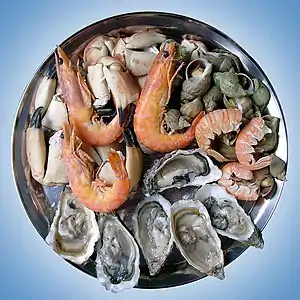Boiled fish
Boiled fish, or precisely salt-boiled fish is fish boiled with salt and thus preserved for later consumption.[1] Although the method is used in other parts of the world, it is only of major commercial significance in Southeast Asia. The shelf life of the products varies from one or two days to several months. In Indonesia, this fish preservation method is known as pindang.[1]

Preservation method
Boiled fish employed the preservation technique both through the exposure of high temperature and salting. The high temperature of boiled water killed microbes that might decompose the fish flesh, while the application of salt promote the preservation.
This technique is especially prevalent in the tropics during monsoon season, since the torrential rains would hinder the simpler and traditional sun-dried method of salted fish.
Pindang preparation is often called the "wet preservation", i.e. after covered in coarse salt, instead of being dried in the sun like salted fish, it is boiled on a low flame until the liquids are evaporated and the salt seasoning absorbed well into fish.[2] Compared to salted fish, boiled uses less salt, thus the taste is not as salty as salted fish.
Although the basic ingredients often only involved fish, water and salt; other ingredients, especially spices or herbs that contains tannin might be added to assist preservation effectiveness.[3] The source of tannin usually turmeric, tamarind, shallot skin, teak leaves, guava leaves, tea, soy sauce, or other spices common in Southeast Asia. This gives the food a yellowish to brown color and lasts longer compared to plainly boiled fish.
Regional variation
_in_de_visinzoutingsloods_te_Blimbing_Oost_Java_TMnr_10014130.jpg.webp)
In Indonesia, various boiled fish products are generally known as pindang,[1] which is often described as Indonesian salt-boiled fish.[4]
See also
References
- "Fish Handling, Preservation and Processing in the Tropics: Part 2 (NRI): Boiled fish products". www.nzdl.org. Retrieved 2020-10-02.
- "Fish on the menu". The Jakarta Post. 1 August 2010. Retrieved 2020-10-01.
- "Pengolahan Jamur Komersial, Jahe Instan, Ikan Asap, Telur Pindang" (PDF) (in Indonesian). Jurusan Teknologi Pangan dan Gizi-IPB. pp. 103–104. Bogor. Archived from the original (PDF) on 2014-04-13.
- Hall, George M. (1997-07-31). Fish Processing Technology. Springer Science & Business Media. p. 61, 62. ISBN 978-0-7514-0273-5.
